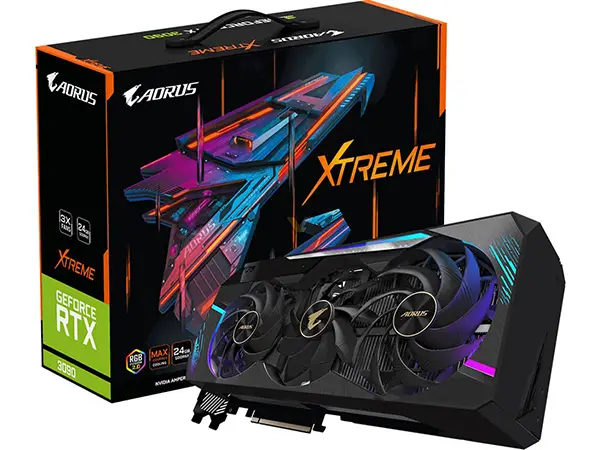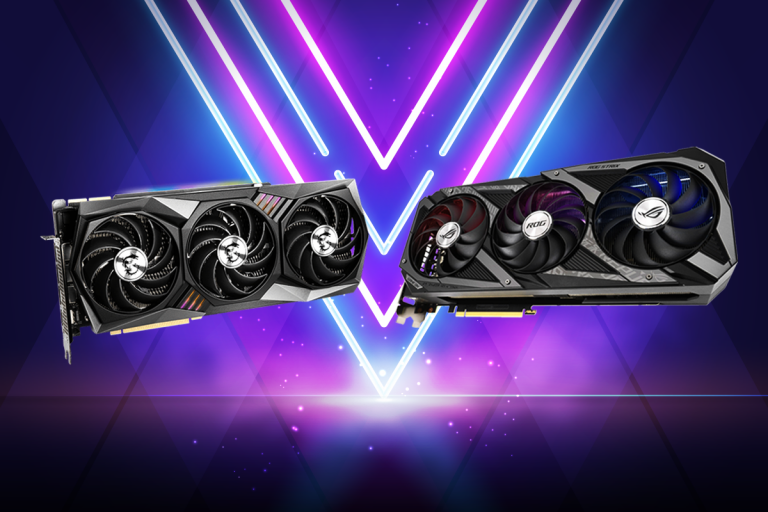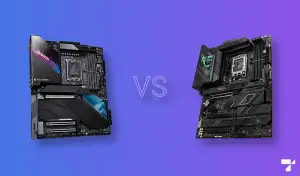RTX 3090 GPUs are finally here, ushering in Nvidia’s Ampere architecture. This GPU comes with a new generation of Ray Tracing and Tensor cores including double the throughput of the previous generation, along with faster GDDR6x memory. The RTX 3090 card also features support for HDMI 2.1, which will allow you to hook up an 8K monitor or TV with a single cable to play games at 8K, which this card can handle. Therefore, we have created this comprehensive review of the best RTX 3090 graphics cards.
Additionally, Nvidia claims the RTX 3090 provides TITAN level of performance as well as the ultimate gaming experience. However, its $1499 MSRP price tag (if you can get it anywhere near this price) does not justify the use of the card for gaming when compared to the RTX 3080 Ti or the RTX 3080 which comes in at $699 MSRP (if you can get it anywhere near this price) with rendering performance in the vicinity of the 3090. Though, professional and creative GPU intensive applications can significantly benefit from the 24 GB of video memory, which justifies the price compared to the more expensive Quadro cards.
So whether you are a creative or professional looking for a powerful card that can tear through your workloads or a gaming enthusiast looking to play the latest titles at 8K and have the cash to spare, the RTX 3090 will not let you down. Many manufacturers have released their custom versions of the card, and you should check out this guide that goes over the 10 best RTX 3090 cards available right now.
 RTX 3090 Comparison Table:
RTX 3090 Comparison Table:
|
1
ASUS ROG Strix GeForce RTX 3090
|
Features:
|
Specs:
|
Check Price |
|
2
EVGA GeForce RTX 3090 FTW3 ULTRA GAMING
|
Features:
|
Specs:
|
Check Price |
|
3
AORUS GeForce RTX 3090 MASTER
|
Features:
|
Specs:
|
Check Price |
|
4
MSI Gaming GeForce RTX 3090 Gaming X Trio
|
Features:
|
Specs:
|
Check Price |
|
5
ASUS TUF Gaming GeForce RTX 3090
|
Features:
|
Specs:
|
Check Price |
|
6
AORUS GeForce RTX 3090 XTREME
 |
Features:
|
Specs:
|
Check Price |
|
7
Gigabyte GeForce RTX 3090 Eagle OC
|
Features:
|
Specs:
|
Check Price |
|
8
MSI RTX 3090 Ventus 3X OC
|
Features:
|
Specs:
|
Check Price |
|
9
ZOTAC Gaming GeForce RTX 3090 Trinity
|
Features:
|
Specs:
|
Check Price |
|
10
PNY GeForce RTX 3090 XLR8 Triple Fan
|
Features:
|
Specs:
|
Check Price |
10 Best RTX 3090 Graphics Cards
1. ASUS ROG Strix GeForce RTX 3090
Specifications
Stream Processors: 10,496 | Base/Boost Clock: 1890 MHz/2437 MHz | Memory: 24 GB GDDR6X | Memory Clock: 19.5Gbps | Power Connectors: 3x PCIe 8-pin | Outputs: 2x HDMI 2.1, 3x DisplayPort 1.4aThe ROG Strix RTX 3090 is ASUS’s flagship RTX 3090, providing a comprehensive cooling solution, improved clock speeds, and a larger power limit. These features make it an excellent option if you are looking to push the card to its limits through overclocking to get the best out of the card.
The card comes with ASUS’s new cooling solution for the RTX 30 series. The three fans now feature a larger number of fins with a larger surface area to push more air into the heatsink and follow the new trend of spinning the center fan in the opposite direction to reduce turbulence and smoothen airflow. In a bid to keep the system noise low and increase fan lifespan, the fans stop spinning for temperatures below 55 degrees.
The heatsink is more refined with a massive 2.9-slot thickness and a polished heat spreader to dissipate heat more effectively. With this card, ASUS highly focused on keeping the temperatures down, which leads to higher noise, but the Dual BIOS option will let you run a ‘quiet’ BIOS for lower noise, at the cost of performance.
The excellent cooling solution has led ASUS to go with a higher board power at 480W, which is way higher than the stock limit, which comes at the cost of needing 3 PCIe 8-pin power connectors, so make sure the power supply you plan on using supports the card. The larger form factor of the card also makes it necessary to have a case that will provide sufficient airflow for the best performance.
The board also includes two PWM fan headers for convenient connectivity with chassis fans. An extra HDMI 2.1 port on the back is great for dual monitor setups. Most of the card’s RGB is present on the top since this will be the most visible in a case and works with ASUS’s AuraSync functionality.
All these features combined make the ROG Strix RTX 3090 one of the best 3090’s out there, although the $300 price premium may be difficult to digest. If you are sure to use the buffed-up power limit and cooling to overclock the card and have the money to spend, then the GPU is the best ones out there.
2. EVGA GeForce RTX 3090 FTW3 ULTRA GAMING
Specifications
Stream Processors: 10,496 | Base/Boost Clock: 1800 MHz/2437 MHz | Memory: 24 GB GDDR6X | Memory Clock: 19.5Gbps | Power Connectors: 3x PCIe 8-pin | Outputs: 1x HDMI 2.1, 3x DisplayPort 1.4aThe FTW3 RTX 3090 is a custom design from EVGA with an advanced cooling system and excellent overclocking software support. The FTW3 series is the flagship of EVGA’s lineup of graphic cards, and we see nothing but the best on the RTX 3090 version.
The cooling system employs EVGA’s signature iCX cooling solution. The 3rd generation iCX3 comes with an improved fan design that includes the center fan being offset by 10mm to increase the area for airflow, a larger copper heat spreader for broader coverage of the GPU and VRAM, complete heat pipe design for a larger contact area, and cutouts on the PCB and backplate to allow air to prevent warm air from recirculating.
A unique technology employed is the use of asynchronous fans, which will spin the fans at the necessary speed based on the measurement from the nine temperature sensors, significantly reducing noise and increasing the lifespan. For temperatures below 55°C, the fans completely stop spinning.
The card comes with three 8-pin PCIe power connectors, which is justifiable considering the GPU’s power consumption at higher clock speeds, so make sure your power supply is up to the mark before buying the card. Also, the 2.5-slot thickness and 30cm length, while slightly smaller than other flagship RTX 3090s, will still need a large case for sufficient airflow.
A large LED strip on the top of the card features an ARGB LED and can work with RGB software to light up your build. EVGA’s Precision X1 software is excellent for overclocking and includes an intuitive interface that can be used by most people to push the maximum performance out of your card.
Overall, the FTW3 RTX 3090 makes for an excellent buy if you are a tech enthusiast looking to lay hands on the latest, most powerful graphic card out there and push the card to its limits through overclocking, or a professional looking to save time rendering large workloads. If you have $1800 to spare and believe the card is right for you, it is a good choice.
3. AORUS GeForce RTX 3090 MASTER
Specifications
Stream Processors: 10,496 | Base/Boost Clock: 1,395 MHz/1785 MHz | Memory: 24 GB GDDR6X | Memory Clock: 19.5Gbps | Power Connectors: 2x PCIe 8-pin | Outputs: 3x HDMI 2.1, 3x DisplayPort 1.4aGigabyte’s Aorus Master RTX 3090 certainly seems to impress with its chunky and unique design and innovative cooling solution that will enable you to run the RTX 3090 great at its intended settings, giving you the best bang for your buck, although it will not take you far in terms of overclocking.
Gigabyte has debuted its latest max-covered cooling solution that brings many innovations in the fan and heatsink design. The three fans feature a stacked structure where the central fan overlaps the two outer fans to provide a uniform airflow through the heatsink. The peripheral fans also include air channeling systems that distribute the air more efficiently while they spin in the opposite direction to the central fan to reduce turbulence significantly.
The heatsink consists of a larger vapor chamber with direct contact with the GPU and VRAM modules with a heat pipe system to draw heat away. The heat sink has angular fins that help in increasing the surface area for better heat dissipation. The heatsink’s extended design, coupled with a cutout on the backplate, allows air to flow straight through for better cooling. These features combined cool the card so effectively that the fans don’t even turn on when the GPU is idle or crunching through light workloads.
The card includes two 8-pin power pins, one less than what the other cards offer, but should run the card great at the factory overclocked settings, but can hinder you from pushing the card too far. The card is still pretty thick, and with a length of almost 32 cm, a large form factor case with excellent airflow is a must.
There are 3 HDMI 2.1 ports, which is the highest currently among any other 3090 and is an excellent option for multi-monitor setups. RGB is limited to just accents and syncs with Gigabyte’s RGB Fusion 2.0, but the tiny LCD monitor can provide valuable information like the temperature and more. The card also supports a Dual BIOS with a silent profile option to keep down system noise. Two LED indicators are also present near the power pins and flash in the event of an abnormality.
While not as powerful as Gigabyte’s Xtreme version of the RTX 3090, the Master RTX 3090 manages to provide a flagship cooling solution that will let you run higher clocks for more extended periods. Overclocking will be limited by the two-pin power supply, but should not be a significant problem for most buyers of this card.
4. MSI Gaming GeForce RTX 3090 Gaming X Trio
Specifications
Stream Processors: 10,496 | Base/Boost Clock: 1785 MHz/2437 MHz | Memory: 24 GB GDDR6X | Memory Clock: 19.5Gbps | Power Connectors: 3x PCIe 8-pin | Outputs: 1x HDMI 2.1, 3x DisplayPort 1.4aThe Gaming X Trio is the flagship of MSI’s RTX 3090 lineup and includes all the bells and whistles you would expect from a premium RTX 3090 graphics card. The second-generation Tri Frozr thermal design, factory overclocking, and more make this an excellent buy for those looking for a no-compromise card for their needs.
MSI’s Tri Frozr 2 cooling starts with a unique, linked fan design with every two blades connected via an outer ring. MSI claims that this significantly helps channel the airflow through the heatsink. Instead of using a traditional heat spreader, MSI decided to have the GPU directly contact the heat pipes, which square off over the chip, letting the heat flow evenly along the heatsink.
MSI also included heat pipes on the metal backplate, which helps improve the heat dissipation. The heatsink design includes deflectors for an increase in surface area and unique fins that damp the sound. If the GPU is idling or under light loads, the fans completely shut off, significantly reducing system noise. These tweaks make Gaming X Trio substantially quieter than other cards, though if you are pushing the card to its limits, you may experience high temperatures.
The three 8-pin connectors will enable the card to reach a power consumption in the vicinity of 400W, which is more than the stock limits set by Nvidia. This extra power will let you push out a little bit of performance out, mostly through overclocking. The card is also pretty massive, coming in at a length of 32.3 cm and weighing around 1.5 kg. A large case with substantial ventilation should do this card well, and MSI has included a GPU support brace to prevent the card from sagging over time.
RGB on the card is minimal with a few accents and a light-up logo that works with MSI’s Mystic Light software. MSI’s Afterburner is one of the best overclocking software out there and natively supports the card. You can also use the Dragon Centre for monitoring clocks and temps in real-time. BIOS options include one for low temperatures and the other for low system noise.
The MSI Gaming X Trio is an excellent card for those looking to lay their hands on one of the most powerful RTX 3090’s out there. Although it might not have the power headroom as other cards, it manages to provide power in a relatively quiet package, and if acoustics is a crucial factor to you, then this card is your best option.
5. ASUS TUF Gaming GeForce RTX 3090
Specifications
Stream Processors: 10,496 | Base/Boost Clock: 1725 MHz/2437 MHz | Memory: 24 GB GDDR6X | Memory Clock: 19.5Gbps | Power Connectors: 2x PCIe 8-pin | Outputs: 2x HDMI 2.1, 3x DisplayPort 1.4aThe ASUS TUF is a custom take on the RTX 3090 that manages to offer marginal performance gains over the base model RTX 3090 while integrating an excellent cooling solution capable of keeping temperatures low and using durable components in the PCB to increase longevity, keeping true to the TUF moniker.
The cooling solution employs a similar method to the Strix cards with axial-tech fan design. The fusing of the fan blades with the outer ring allows the fans to push more air than traditional solutions. The central fan spins in the opposite direction to the two peripheral fans to reduce the turbulence and increase pressure for smoother airflow. Fans stop rotating under 55 degrees, and the card completely switches over to passive cooling, significantly lowering the noise.
A precision smoothened heat spreader coupled with a 2.7-slot wide heatsink, allows for excellent heat dispersion for both the GPU and VRAM, which come with their custom heatsinks. Two 8-pin PCIe power connectors are present, adequate for the card’s power need for regular use without user overclocking. The card features premium components for the VRMs and chokes, adding to the lifespan of the card.
The card features a BIOS switch on the back for support for a Dual BIOS. The backplate also features a cutout for letting warm air pass through, reducing the chances of recirculation. The logo features RGB lighting that is compatible with AuraSync, and an LED indicator is present to aid in troubleshooting power problems.
The TUF RTX 3090 makes for a compelling buy, for its excellent build quality, premium components, and a lower price than the competition. You will not get the best clock speed out of this card considering the power limit, but the performance downgrade is minimal when compared to the savings.
6. AORUS GeForce RTX 3090 XTREME
Specifications
Stream Processors: 10,496 | Base/Boost Clock: 1,395 MHz/1,860 MHz | Memory: 24 GB GDDR6X | Memory Clock: 19.5Gbps | Power Connectors: 3x PCIe 8-pin | Outputs: 3x HDMI 2.1, 3x DisplayPort 1.4aThe Aorus Xtreme is Gigabyte’s premium version of the RTX 3090 and includes several upgrades like the advanced air cooling system and an LCD screen over the standard RTX 3090. It shares many of its features with the Aorus Master but uses an extra power connector to guarantee the best performance possible.
The fan system features a triple fan layout, with the slight overlap of the fan blade tips and alternate spinning of the fans to reduce turbulence and increase the air pressure on the heatsink for better, smoother airflow. Beneath the two side fans lies an air channeling system that helps direct the airflow more evenly to cover the heatsink completely.
For the GPU and VRAM modules, a large copper plate and heat pipe system with direct contact to individual components ensures proper heat removal without leaving any hotspots. The heatsink goes beyond the PCB and allows air to flow through it and out from a backplate cutout, allowing for more airflow. The fins on the heatsink feature an angular design for a larger area for heat dissipation. Passive cooling can handle the card at idle or lighter workloads, which ensures no fan noise.
The three-pin power to the card will ensure an ample amount of power headroom for heavy workloads requiring higher clocks. It even can come handy in overclocking for better performance, though you will need a higher capacity power supply than the one necessary for a stock 3090. The card features two additional HDMI 2.1 ports, which can help in powering a multi-monitor setup. RGB is limited to accents and works with the Fusion 2.0 software, but the tiny LCD on the top will allow you to monitor real-time temperatures and more.
The Aorus Xtreme RTX 3090 adds even more performance to the already powerful card. With the extra power, you can expect significant improvements over stock, though it makes sense to pursue the cheaper alternatives unless you plan on overclocking.
7. Gigabyte GeForce RTX 3090 Eagle OC
Specifications
Stream Processors: 10,496 | Base/Boost Clock: 1,395 MHz/1,725 MHz | Memory: 24 GB GDDR6X | Memory Clock: 19.5Gbps | Power Connectors: 2x PCIe 8-pin | Outputs: 2x HDMI 2.1, 3x DisplayPort 1.4aThe Gigabyte Eagle OC is a custom RTX 3090 that aims to service the card’s value end, offering a slight bump in performance over the reference design while not charging as much of a price premium as other custom boards costing the same as Nvidia’s Founder’s edition.
The cooling system includes three fans, which are smaller than other cards like Gigabyte’s own Aorus series, which will inevitably mean running the fans at a higher speed leading to increased system noise. The alternate spinning of fans will reduce turbulence and allow for smoother airflow through the system.
The fans also turn off at lower temperatures to reduce the system noise. The large copper plate comes in contact with both the GPU and VRAM, allowing for lower temperatures. The heatsink also extends beyond the board to increase the amount of air flowing through it via the metal backplate cutout, leading to better heat dissipation.
The two PCIe power connectors will allow for a maximum of 385 watts op power for your card, which, although not the highest, should run the card at its factory settings, but will not prove much in the way of overclocking. Gigabyte also employs an improved power phase design to improve the card’s durability and increase the boost clock duration. The card features an additional HDMI 2.1 port if you need to use it with another monitor. RGB on the card is limited to the logo and a few accents and works with Gigabyte’s Fusion RGB 2.0.
Coming in at the same price as a Founder’s Edition, the Eagle OC RTX 3090 offers an excellent cooling solution, a factory overclock, and more, making it a viable choice if you don’t want to overstretch your budget and don’t need the overclocking abilities.
8. MSI RTX 3090 Ventus 3X OC
Specifications
Stream Processors: 10,496 | Base/Boost Clock: 1785 MHz/2437 MHz | Memory: 24 GB GDDR6X | Memory Clock: 19.5Gbps | Power Connectors: 2x PCIe 8-pin | Outputs: 1x HDMI 2.1, 3x DisplayPort 1.4aMSI’s Ventus 3X offers excellent value for those eager to pick up an RTX 3090. It manages to provide an ideal cooling solution and a base clock well above stock while not costing significantly more than the Founder’s Edition.
The new generation of Torx Fans features a sculpted design that ensures increased air pressure than regular fans, letting them run at much lower speeds, thereby reducing the noise. When temperatures are relatively low, the fans switch entirely off, allowing the card to be cooled passively to lower noise and increase fan lifespan.
Instead of using a copper base plate, MSI used precision machined square heat pipes that directly contact the GPU, helping distribute the heat more evenly through the heatsink. An increased number of thermal pads also help in transferring the heat effectively. The back metal plate also includes two heat pipes to cool the memory modules at the PCB’s back.
MSI makes sure to reduce the GPU sag by bundling a special bracket that helps support the card in the case. The card comes with two PCIe 8-pin power connectors for power, suitable for running the card at its intended clock speeds.
The Ventus 3X RTX 3090 offers a minor performance upgrade over the Founder’s Edition while costing almost as much while including an enhanced cooling system and factory overclocking, making it one of the best value cards out there.
9. ZOTAC Gaming GeForce RTX 3090 Trinity
Specifications
Stream Processors: 10,496 | Base/Boost Clock: 1695 MHz/2437 MHz | Memory: 24 GB GDDR6X | Memory Clock: 19.5Gbps | Power Connectors: 2x PCIe 8-pin | Outputs: 1x HDMI 2.1, 3x DisplayPort 1.4aThe Zotac RTX 3090 Trinity is a custom board that offers a unique aesthetic with an advanced cooling solution that allows it to perform well while coming in at a slimmer form factor when compared to other offerings.
The Ice Storm 2.0 cooling solution, specially made for the new RTX 30 series of cards, includes an 11-blade fan design for all three fans, which provides a 10% airflow increase compared to previous generations. The fans completely stop spinning on idle or light workloads, letting the GPU cool passively, significantly reducing the system noise.
Zotac also made use of densely packed heatpipes that directly contact the GPU, which would ensure a uniform transfer of heat through the heatsink. The seven heatpipes dissipate heat through a three-group aluminum fin-stack array heatsink. The 2.5-slot thickness is pretty slim for an RTX 3090, though the cad is quite long at 31.7 cm.
The two 8-pin power pins are more towards the center, so you may need to keep that in mind when routing your power cables. The power delivery is sufficient for regular use and should be enough for most use cases. The Zotac Gaming and Zotac logo on the back support RGB that works with the Spectra 2.0 software. For overclocking and setting the individual fan speeds, the Firestorm utility should have you covered.
Overall, the Zotac RTX 3090 Trinity is a slim card that offers an excellent cooling solution that might let you play around with some overclocking, but it is best suited for those using the card at its stock settings.
10. PNY GeForce RTX 3090 XLR8 Triple Fan
Specifications
Stream Processors: 10,496 | Base/Boost Clock: 1695 MHz/2437 MHz | Memory: 24 GB GDDR6X | Memory Clock: 19.5Gbps | Power Connectors: 2x PCIe 8-pin | Outputs: 1x HDMI 2.1, 3x DisplayPort 1.4aThe XLR8 Triple Fan by PNY is an RTX 3090 that is identical in performance to the Founder’s Edition while employing a triple-fan cooling system to improve the thermal performance and featuring a more gamer-oriented aesthetic.
The cooling system involves three fans and a massive 3-slot heatsink for keeping temperatures low. While the translucent plastic fans are not as good looking as other custom models, they still manage to do their job in maintaining proper airflow. Six heatsinks help transmit the heat from the GPU to the heatsinks.
The card includes two 8-pin PCIe connectors, which are enough for running the card at stock speeds, though you may be able to push it a bit further through overclocking. The GeForce RTX logo and a few accents feature ARGB LEDs and help light up your PC build. The card’s considerable 31.6 cm length will undoubtedly require a large case, especially with good airflow, to keep the card cool.
If you were looking for a custom RTX 3090 card that does the job without charging a price premium, the PNY FTW3 Triple Fan is what you need as it will happily run on stock speeds, which the cooling system is more than capable of handling.
Final Thoughts
The RTX 3090 is the most powerful graphics card for gaming yet, and with AiB’s like the Strix 3090 reaching almost 480W of power consumption, we see diminishing returns on the efficiency of the card. If you have a workload that involves a high amount of VRAM, the RTX 3090 makes complete sense, but we highly recommend passing the 3090 and going for the 3080 instead if you just want to game. Lastly, you can learn more about how to choose the best GPU for you.



